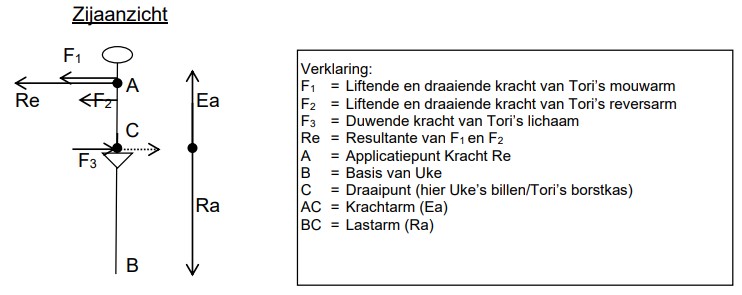Ushiro-goshi – 後腰 – Rear Hip Throw
Classification: Nage-waza (throwing technique) – Koshi-waza (hip technique)
Type: Counter throw
Kodokan-recognised technique
Difficulty: ★★★★☆
Technical Description
Ushiro-goshi, or “Rear Hip Throw”, is a powerful counter-throw executed when uke attempts a forward hip throw such as Harai-goshi or O-goshi.
As uke initiates their attack, tori avoids the entry by stepping aside or backwards and wraps their arms from behind around uke’s waist. Tori then uses a lifting motion, elevating uke’s hips into the air, and throws uke backwards and down onto the mat.
This dynamic counter requires precise timing, excellent core strength, and keen awareness of body positioning.

Biomechanics of Ushiro-goshi
Ushiro-goshi is executed through a lever mechanism, combined with explosive lifting force:
-
Fulcrum (C): The pivotal point is the axis of rotation around tori’s lower body.
-
Force (F3): Tori wraps the arm around uke’s waist and lifts vertically.
-
Control (F1 & torso): The arms and tori’s upper body guide uke into a controlled rearward fall.
-
The throw is ideally performed without rotating uke, sending them vertically up and backward into a clean landing on the mat.
Proper posture, balance, and controlled explosive power are critical to avoid injury and maintain stability during execution.

Did You Know?
There is a Kodokan kata based on hardness and resistance called Gō-no-kata (剛の形) – often translated as Forms of Strength or Hardness Kata.
-
It was developed around 1887, during the same period as more widely known kata like Nage-no-kata and Katame-no-kata.
-
Gō-no-kata is considered the opposite of Jū-no-kata (柔の形), which is based on flexibility and yielding.
-
In this rare and physically demanding kata, Ushiro-goshi is performed twice – appearing as the second and second-to-last technique, showcasing the emphasis on resilience and controlled force.
Because of its complexity and intensity, Gō-no-kata is rarely taught or performed today, making the appearance of Ushiro-goshi within it a noteworthy detail in judo’s classical evolution.